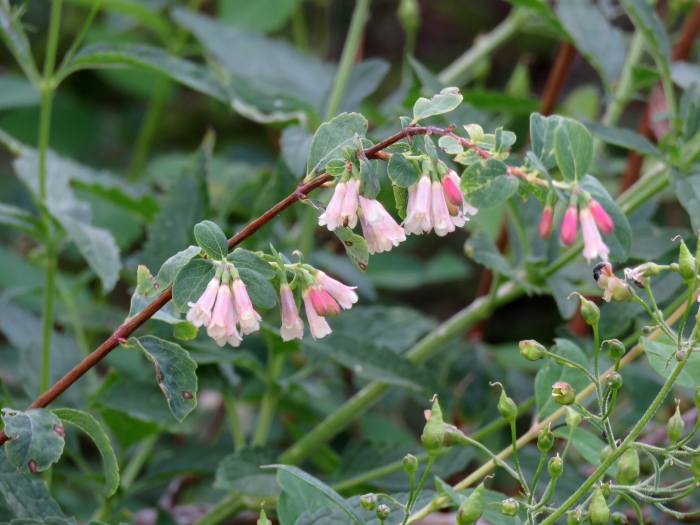Roundleaf Snowberry
(Symphoricarpos rotundifolius)
Roundleaf Snowberry (Symphoricarpos rotundifolius)
/
/

© Katja Schulz
CC BY 4.0
Image By:
© Katja Schulz
Recorded By:
Copyright:
CC BY 4.0
Copyright Notice:
Photo by: © Katja Schulz | License Type: CC BY 4.0 | License URL: http://creativecommons.org/licenses/by/4.0/ | Uploader: treegrow | Publisher: iNaturalist |

















































Estimated Native Range
Summary
Symphoricarpos rotundifolius, commonly known as Roundleaf Snowberry, is a deciduous shrub native to a variety of habitats including open woodlands, forest edges, and riparian areas in the Western United States and Northwest Mexico. This plant typically grows 2 to 4 feet (0.61 to 1.22 m) tall and features stiff, spreading branches. The leaves are rounded, giving the plant its common name. The flowers, which bloom from June to August, are small with pink to white corollas and are shaped like narrow bells with lobed mouths. They are not particularly showy but are attractive up close. The fruit is a distinctive white berry-like drupe about a centimeter wide, which persists into winter and is a food source for birds.
Roundleaf Snowberry is valued for its wildlife-friendly berries and its ability to form dense thickets, making it useful for erosion control and as a low-maintenance ground cover in restoration projects and naturalistic plantings. It is also used in urban planting and border planting for its tolerance of a range of conditions, including drought once established. Roundleaf Snowberry thrives in full sun to part shade and prefers well-drained soils but can tolerate a variety of soil types. While generally disease-resistant, powdery mildew can be a problem in humid conditions. It is not known for aggressive roots or significant disease issues, but its suckering habit can make it somewhat invasive in garden settings.CC BY-SA 4.0
Roundleaf Snowberry is valued for its wildlife-friendly berries and its ability to form dense thickets, making it useful for erosion control and as a low-maintenance ground cover in restoration projects and naturalistic plantings. It is also used in urban planting and border planting for its tolerance of a range of conditions, including drought once established. Roundleaf Snowberry thrives in full sun to part shade and prefers well-drained soils but can tolerate a variety of soil types. While generally disease-resistant, powdery mildew can be a problem in humid conditions. It is not known for aggressive roots or significant disease issues, but its suckering habit can make it somewhat invasive in garden settings.CC BY-SA 4.0
Plant Description
- Plant Type: Shrub
- Height: 3-5 feet
- Width: 3-5 feet
- Growth Rate: Moderate
- Flower Color: Pink
- Flowering Season: Summer
- Leaf Retention: Deciduous
Growth Requirements
- Sun: Full Sun, Part Shade
- Water: Medium
- Drainage: Medium
Common Uses
Bee Garden, Bird Garden, Butterfly Garden, Deer Resistant, Drought Tolerant, Erosion Control, Hummingbird Garden, Low Maintenance
Natural Habitat
native to a variety of habitats including open woodlands, forest edges, and riparian areas in the Western United States and Northwest Mexico
Other Names
Common Names: Coralberry, Round-Leaved Snowberry, Symphorine À Feuilles Rondes
Scientific Names: , Symphoricarpos rotundifolius, Symphoricarpos vaccinioides, Symphoricarpos rotundifolius var. rotundifolius, Symphoricarpos rotundifolius var. vaccinioides, Symphoricarpos austiniae, Symphoricarpos glabratus, Symphoricarpos glaucus, Symphoricarpos parvifolius,
GBIF Accepted Name: Symphoricarpos rotundifolius A.Gray